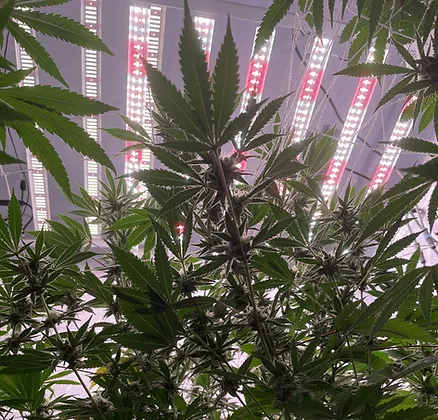Exploring LED Technology – Blurple vs. Full Spectrum


LED technology is an exciting and evolving subject. In our blog, Choosing the Right LED for your company we explored the importance of looking at materials, warranty, and certifications that form a quality LED fixture. However, that is only one piece of the large LED puzzle. One of the biggest components to look at is light wavelengths. Specifically, those that will best compliment your cultivar and bring out the full potential of your crop.
Advancements in wavelength research and technology present an opportunity for manufacturers to choose the wavelengths that will maximize the potential in various plants and Controlled Environment settings. These advancements allow growers to take control and select the best LED according to the needs of the plant. With all the options available on the market today, the true challenge lies in understanding which light is best at achieving the results you seek in your cultivar.
How technology is transforming Indoor Growing Spaces
As technology in LEDs continues to advance, so does the range of products entering the marketplace. Manufacturers are tailoring lights to respond to various circumstances, including lights for vegetative states and flowering. Today there are two LED lighting types that are most seen in growing facilities: Red/Blue wavelength-commonly known as Blurples and Full Spectrum.
Narrowing in on Blurples
Blurples are one example of a narrow wavelength that have maintained popularity within the cannabis space.
Blurples are made up of a combination of blue and red diodes so that the resulting colour appears a bluish purple. The red light is usually the highest percentage, between 75 and 90, and the blue diodes usually account for about 10 to 25 per cent.
A selection of growers believe that growing under Blurples is the most effective way to grow plants because they don’t include wavelengths like “green, yellow, and orange”, which are often underutilized by the plant. Blurples can be incredibly efficient because of the large percentage of red diodes found in the lights, however there are a few challenges:
-
It can be very difficult for growers to work under these coloured lights. Blurples have been known to both cause headaches and have the potential for mood-altering impacts on growers and staff.
-
The purple hue can make it challenging to see the true colour of the plant. This could result in the grower missing early signs of disease or discolouration, which are a key indicator of the overall health of the crop.
-
The full potential of the various wavelengths, such as green and yellow, in LEDs are still being discovered. Therefore, when growers choose to restrict their plant to a specific wavelength they may not be getting the full potential out of the genetics.
Factoring in the Benefits of Full Spectrum LEDs
Full spectrum lighting has come a long way since it was initially used for plants. Today, manufacturers have narrowed down what is best for plant growth and harnessed this information to create LED spectrum recipes that optimize the growth potential in plants. Years of growing and LED research continually demonstrates that plants benefit from a variety of wavelengths; not just the two most well-known light spectrums- Red & Blue


Research in horticulture lighting has also shown us that although plants prefer more than just red and blue, they don’t use all the wavelengths produced in sunlight. In fact, if LED companies truly used the full solar spectrum, efficiency would go out the window. However, science has also discovered that plants need more than just red and blue wavelengths. This is why we’ve engineered Aelius LED lights to optimize the full spectrum, by including the wavelengths that the plant needs within the full range of visible light.
It’s about cultivating an environment that is both energy-efficient, while also providing the plant with the “next-best-thing” to the sun.
If sunlight is so great, why not just grow outdoors?
There is no question that full sunlight is the ideal lighting to nurture your cannabis plant. (Read our blog on manipulating the sun, here). However, growing under sunlight can be extremely unpredictable. Clouds, rain, and even the pattern of daylight will change the types of wavelengths that your plants are exposed to throughout the day and can affect plant health.
Alternatively, adopting the horticulture practice of using Controlled Environment Agriculture will ensure a predictable environment for cannabis to thrive. This horticulture method allows the grower to modify the Daily Light Integral (DLI), according to its specific strain needs.
The ability to trigger flower more slowly and naturally, which research has indicated may have benefits to the plant’s metabolic process, can easily be done with a simple controller. The environment is able to be controlled by the grower who can manipulate the lighting according to the needs of the specific strain.
Selecting Spectrums: Does stage of life matter?
When it comes to cannabis, no two cultivars are alike. This is why it’s critical to research the spectrum needs of your specific cultivar to create the lighting environment that will ensure that it will thrive at a specific stage. For example, our Aelius REDD models are designed specifically to optimize the flower cycle of a cannabis plant due to its Far Red spectrum. While our Matrx 630 offers a universal spectrum that can be carried from veg to flower of the plant.
Tip: Ask about and review the spectrum graphs to fully understand the wavelengths of any specific LED. Staff are often very helpful and have more real life insight than what can be found online.
The Takeaway
Know your cultivar, learn how it responds to the various wavelengths and design the space that will maximize its genetic potential. There is a place for both narrow wavelength and full spectrum lights in a Controlled Environment Agriculture, however, identifying your desired results will likely steer you in the right direction when choosing your next LED.






